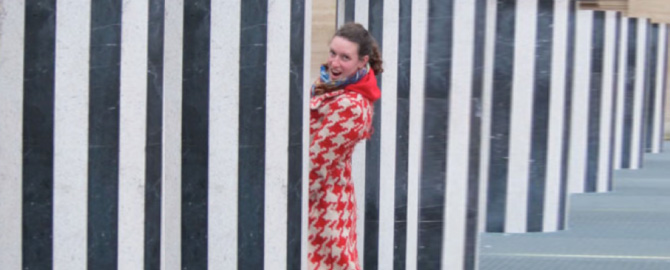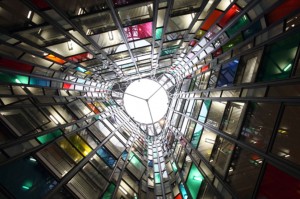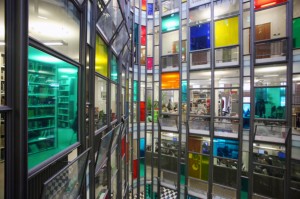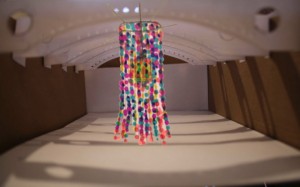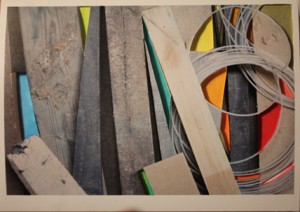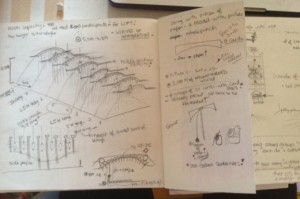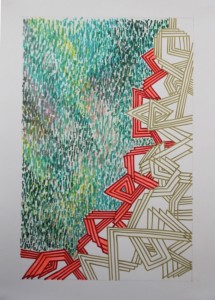
Olympic Fever/Fervor New drawing series, inspired by London 2012 Medium: marker pen on card Size: 6×4 inches Description: I created some small drawings to encapsulate the masses of people, advertisements, and energy that was anticipated and felt in certain corners of the city.
Julia Vogl’s work is ambitious and challenges the public. It does, though, enhance public spaces, a characteristic that Vogl is passionate about. She is an artist on a mission, with clear objectives; Vogl is an advocate for Art Awards and Prizes. These awards help emerging artists with recognition and financial support, elements that are crucially integral to the continuum of new works and ideas coming through. Vogl says, “I believe the power of public art can change a neighbourhood, enhancing community safety and pride. I wish to spend my life as an artist who can contribute to society, enrich and challenge communities, while learning about people and places.”
Vogl marries her Art with politics, an area that she fervently follows and has studied. Her work invokes memories and experiences, that exudes positivity. In a world of global recession, global atrocities, and political deviances, Vogl’s work brings a richness in colour and aesthetic beauty.
In 2012 she was awarded the Catlin Art Prize and was shortlisted for the Jerwood Drawing Prize. For a relatively young artist, she has a CV as long as your arm!
In her own words
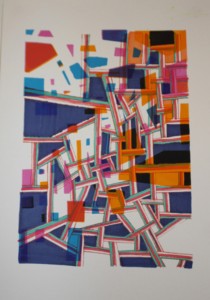
A Place In The Middle Of Everywhere 2012 Materials: Silkscreen and marker pen and collage. A4 series. Description: A psychological understanding of place.
What motivated you to become an Artist? When did you realise you would pursue a life in Art?
I think Art is one of those things you don’t really choose to do, you just have to do it.
My whole life I always did art. When my IB high school teacher encouraged me too apply to art school I didn’t think I was good enough, and then at Oberlin College, it became apparent I had to major in art because I wanted to take every class they were offering. Even then I wasn’t sure it was a professional path for me. I took a lot of politics courses, and dabbled in campaigning. During the summers I worked in a few art galleries in NYC, and I hated it, I felt that the work I loved should be on display to everyone and here it was boxed up for the elite. It started to fall into place when I started working as a project manager for Public Art for Public schools, while working in a studio at
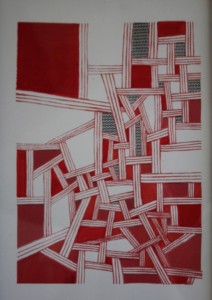
A Place In The Middle Of Everywhere 2012 Materials: Silkscreen and marker pen and collage. A4 series. Description: A psychological understanding of place.
night. By day I was helping artists really succeed and realize great work, and by night I was experimenting with my own ideas. My confidence to pursue public art really was tested when I tired my hands at realizing a Brooklyn Arts Council Grant funded work in Fort Greene Park. I learned so much from both the success and failures of the operation and really came into my own, there was no looking back, this is what I had to do.
Unlike many sculptures, your sculptures are empowered by the strong presence of colour. Are the sculptures related developments to your drawings or are they independent pieces? If they are related then how?
For a while I thought I had a bi-polar practice. On the one hand I was obsessed with drawing, and colours, and lines, and on the other hand I was passionate about mapping and understanding space, creating systems that would allow the public to navigate a concept through an aesthetic experience. But in grad school I started to understand that my way of seeing space and colouring architecture in collages to imagined structures in my drawings was very much engrained in my approach to my social sculptures and installations. I think if you are familiar with my work you can tell that my drawings and installations are clearly done by the same person, but the approach of both works start from very different points.
Color is a subject I am still studying; it is emotional, it is architectural, it is a system of logical ordering, and it is also fun.

Metropolis (London Series of 22) 2011 Medium: Silkscreen with marker pen on paper, 50x 70 cm Description: Metropolis, is a series of 22 unique drawings. Each work has the same silkscreen framework but has been drawn into to make them different. The work was generated from imagined cities based on maps and aerial views of urban density. While a different branch of my practice, the drawings and installations share a strong geometry and colour aesthetic. They also both investigate space. Can be shown as one grouping or in smaller sets.
You create many public installations. How do you see and understand public space and the role of art in public space in todays society?
Social Media is quickly becoming the greatest public space that a society can share. There is a certain intentionality about sharing virtual space. Physical public space, often civic spaces, are used as a means of necessity. One goes to the Library, the Hospital, a school, a park, to share resources that for the most part individuals cannot afford on their own. The individuals are usually not driven by the intentionality to engage with strangers in

LET'S HANG OUT 2012 Materials: carpet tile, Velcro, vinyl and Catlin Art show visitors, 300cm x300cm
these environments, but often they do. The engagement with strangers in these places is generally based on the community’s perception of safety. Art has typically been found in these area’s to further a neighbourhood’s sense of ownership, pride and security – enabling greater relationships between those who share the space. Today I find that art serving the potential of creating safety is a great feat, but perhaps not enough. As our society becomes more and more individual, it is really important to create works in public spaces that challenge one’s expectations- that not only excites a pedestrian but also provokes, that invites them to return, that may disappear but linger as a memory, an experience. Public space holds the capacity to surprise more then work in a gallery and that is really vital for our society today, when it is really hard to create great surprise.
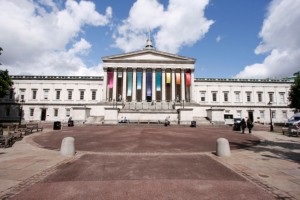
June 2011 Medium: PVC mesh, rope, steel mechanism, UCL Portico and 1000 opinions from Stanmore, Neasden, Kilburn, St. Johns Wood, Bond Street, Westminster, Waterloo, London Bridge, Canary Wharf, and Stratford. Description: This hyperbolic bar chart and colour field painting reflect the public's opinion of where they would allocate a spare million of public spending. I surveyed 1000 people throughout London, a 100 people in 10 different communities, asking them to select one area from the London Greater Authority Budget list. The options were: ARTS & CULTURE (hot pink) BUSINESS & ECONOMY (gray) HEALTH ( seafoam green) HOUSING ( sky blue) EDUCATION ( royal blue) ENVIRONMENT ( turquoise) SAFETY & POLICING ( yellow) SPORTS & OLYMPICS ( orange) TRANSPORTATION ( red). I then made a steel mechanism that with the banners functioned as massive roller blinds. Each day of the show the banners were lowered or raised to reflect a different communities results.
What influences have driven your work and why?
My influences are all at once aesthetic, and political. I am inspired continually by the way that a building juts out in the environment, or the way a Modernist painting makes me so satisfied. At the same time, I am constantly riddled with the political upheaval, and engrossed in how democracy is a dance of politicians, and there is so much pomp and circumstance surrounding public conversation. I studied politics, and there I learned that to be critical of the system was just as much of an asset to the strength of the system. It took me a while to see where I could interject, but my passion for colour, and pattern and systems, soon carved a path where the concept and the aesthetic met.
What elements do you find most challenging in your work?
I constantly am anxious about making work that is not using but giving and provoking. I don’t make my work to make headlines or get great PR, but it is dependent on people engaging, and constantly I have to develop strategies that ensure this dialogue. I always worry when I make a work that people will walk by and not engage with it…this too is a powerful comment, but maybe not the one I had in mind…
Why is the artist in a unique position to make statements that cause us to relate? What do you think the artist offers that say a public speaker, leader or a teacher cannot?
The artist comes with no agenda, but perhaps truth. Nietzche said “ The artist having uncovered the truth garment by garment remains fixed on what is hidden.” Birth of Tragedy.
Over the last 4 years, my work has been dedicated to data, to the process of collecting it. When I worked on a political campaign, I was sitting on the street, with an agenda – to pick my candidate, what can I say to convince you. Now as the artist, I wanted to go back to that street corner with no agenda- to really have a conversation with someone about their politics, about their life choices, about what they were not giving enough time to think about. More importantly I wanted to show them they were not just a cog in a wheel spinning round and round, but an individual with a voice that would be represented. That by sharing their time with me, I would give back to them.
The artist holds a certain amount of sincerity, because they generally have nothing to gain in manipulating the public, except exposing certain insecurities or truths about ourselves or society or the world. Artists operate to prod and ask questions rather then guarantee solutions and provide policy-like strategies to contemporary issues.
It is wrong to think that art can fix poverty or fix crime – but I firmly believe it can improve safety, it can voice concerns that are being oppressed or not discussed, it can coax individuals out of apathy and help society engage with a more meaningful way of life.
What’s next for you?
I am currently working on a few different projects. Recently I have commissioned by Culture 24 to work with the Newcastle Discovery Museum, to create a work for Museum Night. A national event across the UK, many Museums stay open late for the weekend of May 17/18th and host engaging works. I will be working with the community to create a 30 foot chandelier created out of thousands of recycled plastic bottles, illustrating the geography of where in the region the community is from. It will all get created in 3 hours! (Other artists commissioned by Culture 24 are, Martin Creed, Gavin Turk, Chapman Brothers, Richard Wentworth and 4 others)
I am also going to be bringing my project Button Business to Krakow, Poland for the ArtBoom Festival in June. We are hiring a pretzel-vending trolley to circulate the old town of Krakow distributing badges that signify individual’s roles in society and at the festival. Colours will represent categories including: Proud Resident to Hipster to Here for the Beer.
I also have been working on a travelling, portable, self-initiated project called Social Protest. Essentially I have created 5 coloured blank protest signs. Setting myself up in front of local landmarks wherever I am – I have been inviting the passing public to contribute a protest message, and then I have been uploading these onto social media. The work has travelled to: Washington DC, New York City, Boston MA, Williamstown MA, North Adams, MA, Paris France, Lake District UK, Manchester UK, York, UK, Bristol UK, and going to many other future destinations soon!

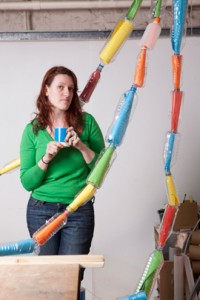 Julia Vogl is an American-British (French speaking) Artist, currently residing in London, who frequently exhibits on both sides of the pond. In 2011 she graduated with an MFA Sculpture, Slade School of Art. In 2007 she graduated from Oberlin College where she studied Politics alongside Studio Art.
Julia Vogl is an American-British (French speaking) Artist, currently residing in London, who frequently exhibits on both sides of the pond. In 2011 she graduated with an MFA Sculpture, Slade School of Art. In 2007 she graduated from Oberlin College where she studied Politics alongside Studio Art.
All images courtesy of Julia Vogl | www.juliavogl.com
Museums at Night: COLLECT. SELECT. STRING & HOIST from Julia Vogl on Vimeo.
For more information on Hong Kong Art Tutoring please contact:
Gail Deayton
Telephone: +852 9722 8353
Email: gd@gaildeayton.com

